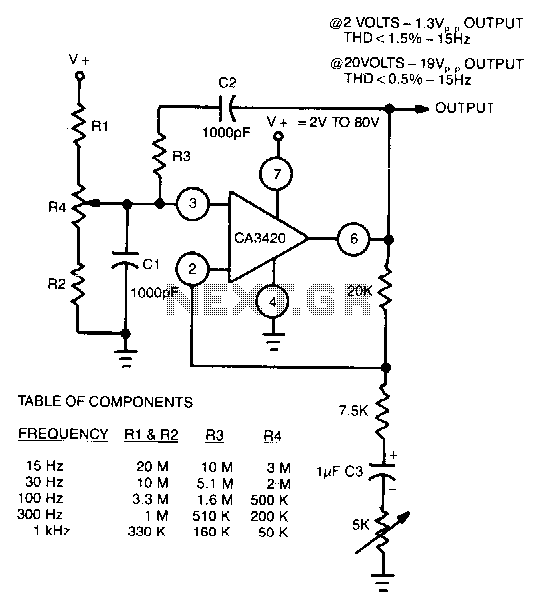
Single-supply-wien-bridge-oscillator

The adjustment of R4 contributes to the comparatively symmetrical output transfer characteristic of the CA3420 BiMOS operational amplifier. To extend the lower operating frequency, remove C3 and use a dual supply.
The CA3420 is a high-performance BiMOS operational amplifier that combines the advantages of both bipolar and CMOS technologies. The adjustment of resistor R4 is crucial in achieving a balanced output transfer characteristic, which is essential for maintaining linearity and minimizing distortion across the output range. By fine-tuning R4, the user can optimize the amplifier's response, ensuring that it performs effectively in various applications.
To enhance the operational frequency range of the CA3420, particularly at lower frequencies, it is recommended to remove capacitor C3 from the circuit. Capacitor C3 typically serves to filter high-frequency noise or stabilize the amplifier's response; however, its presence can limit the lower frequency response. By eliminating this capacitor, the bandwidth of the amplifier can be extended, allowing it to operate effectively at lower frequencies.
Additionally, employing a dual supply configuration is advised when working with the CA3420. A dual supply provides both positive and negative voltage rails, which is beneficial for amplifying AC signals that swing above and below ground. This configuration allows for a more symmetrical output swing, further enhancing the amplifier's performance and making it suitable for a wider range of signal processing applications.
In summary, careful adjustment of R4, removal of C3, and the use of a dual supply are critical considerations for optimizing the performance of the CA3420 BiMOS operational amplifier. These modifications contribute to achieving a symmetrical output transfer characteristic and extending the operational frequency range, thereby improving the overall functionality of the circuit.The Adjustment of R4 contributes to the comparatively symmetrical output transfer characteristic of the CA3420 BiMOS op amp. To extend the lower operating frequency, remove C3 and use a dual supply. 🔗 External reference
The CA3420 is a high-performance BiMOS operational amplifier that combines the advantages of both bipolar and CMOS technologies. The adjustment of resistor R4 is crucial in achieving a balanced output transfer characteristic, which is essential for maintaining linearity and minimizing distortion across the output range. By fine-tuning R4, the user can optimize the amplifier's response, ensuring that it performs effectively in various applications.
To enhance the operational frequency range of the CA3420, particularly at lower frequencies, it is recommended to remove capacitor C3 from the circuit. Capacitor C3 typically serves to filter high-frequency noise or stabilize the amplifier's response; however, its presence can limit the lower frequency response. By eliminating this capacitor, the bandwidth of the amplifier can be extended, allowing it to operate effectively at lower frequencies.
Additionally, employing a dual supply configuration is advised when working with the CA3420. A dual supply provides both positive and negative voltage rails, which is beneficial for amplifying AC signals that swing above and below ground. This configuration allows for a more symmetrical output swing, further enhancing the amplifier's performance and making it suitable for a wider range of signal processing applications.
In summary, careful adjustment of R4, removal of C3, and the use of a dual supply are critical considerations for optimizing the performance of the CA3420 BiMOS operational amplifier. These modifications contribute to achieving a symmetrical output transfer characteristic and extending the operational frequency range, thereby improving the overall functionality of the circuit.The Adjustment of R4 contributes to the comparatively symmetrical output transfer characteristic of the CA3420 BiMOS op amp. To extend the lower operating frequency, remove C3 and use a dual supply. 🔗 External reference